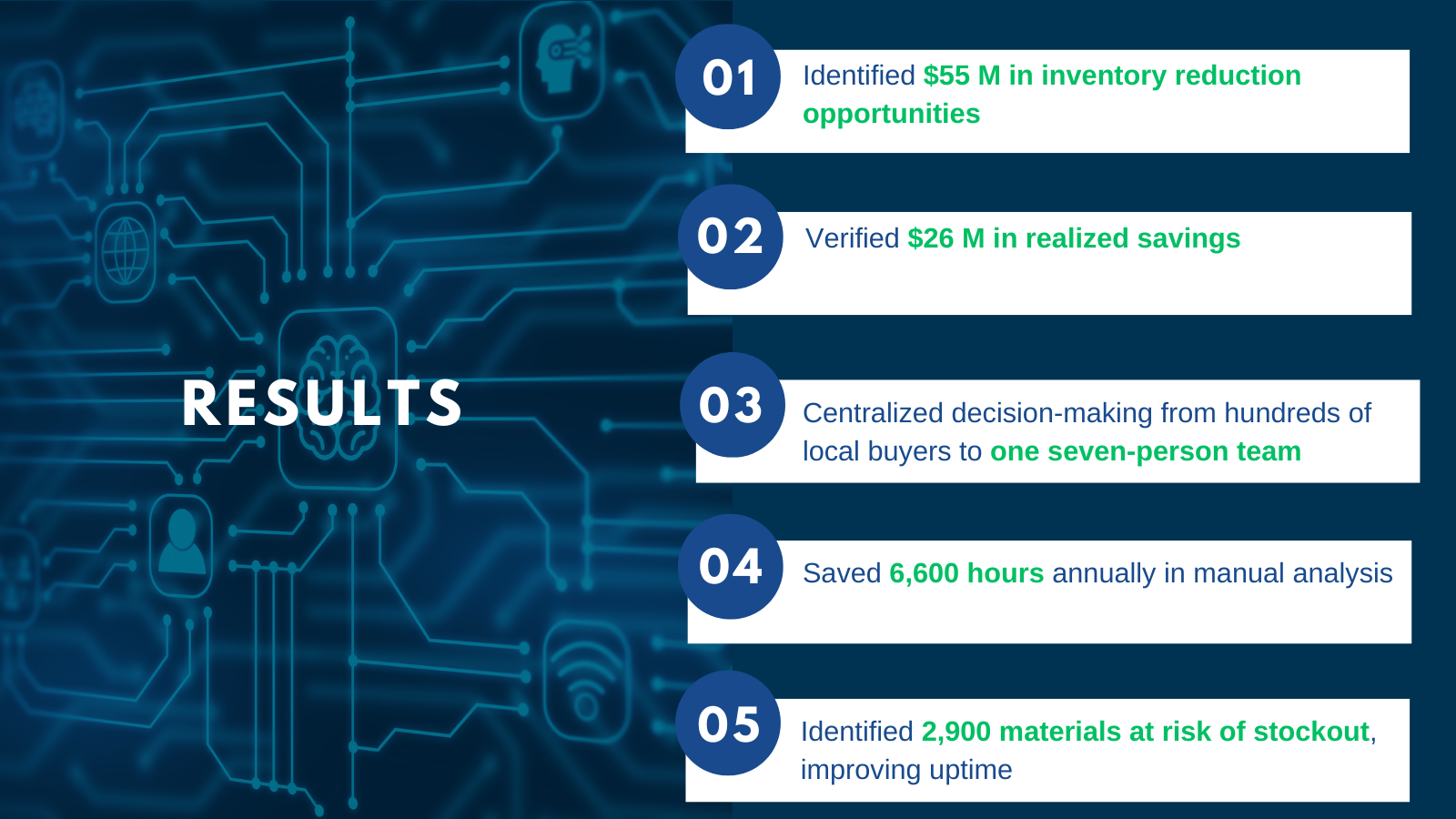How to Choose the Best MRO Inventory Management Software for Enterprise Manufacturers
For Fortune 1000 manufacturers, managing MRO (Maintenance, Repair, and Operations) materials across multiple sites and ERP systems can feel like flying blind. Parts are duplicated, data is unreliable, and millions in working capital sit idle in warehouses.
The right MRO inventory management software can change that. But with so many solutions claiming to use AI, analytics, or automation, how can leaders know which one truly delivers measurable value?
Here’s how to evaluate and select an MRO software platform that doesn’t just track inventory – but transforms it into a strategic asset.

1. Start With a Clear Understanding of Your Data Landscape
Before selecting any software, understand the data challenge you’re solving. Most large manufacturers operate with multiple ERP or EAM systems – SAP, Oracle, Maximo, or Infor – often running in silos after mergers or expansions.
Ask your team:
- How many ERP instances do we operate today?
- How consistent is our material master data across plants?
- Can we identify duplicates and obsolete parts across the network?
If you can’t confidently answer those questions, your first priority isn’t automation – it’s data harmonization. Choose software that can integrate and unify data across every system in your enterprise.
2. Prioritize AI-Driven Visibility Over Manual Data Cleansing
Traditional MRO tools focus on manual data cleansing projects. These are slow, expensive, and outdated the moment they finish.
Modern MRO inventory optimization software uses AI to continuously match, cleanse, and maintain accurate material records. By connecting directly to ERP and procurement data, the software eliminates duplication and surfaces visibility across all sites.
AI-powered visibility means your teams can finally trust what they see – and make informed decisions across maintenance, procurement, and finance.
3. Evaluate Integration Capabilities and Scalability
A key differentiator among MRO software platforms is how well they integrate into existing systems.
Look for:
- Native integration with SAP, Oracle, Maximo, and Infor/Hexagon.
- Real-time synchronization across plants and warehouses.
- Scalability that supports dozens or even hundreds of global sites.
Avoid any solution that requires data migration or duplicate databases. The right software acts as an intelligence layer over your existing systems – not a replacement for them.
4. Measure Financial Impact, Not Features
Your CFO isn’t asking for more features. They want measurable financial outcomes:
- How much working capital will this free up?
- How much downtime will it prevent?
- How quickly will it pay for itself?

Example impact calculation:
For a company with $100 M in MRO inventory, even a 10 percent optimization equals $10M in freed working capital. Add a 25 percent annual carrying cost and you’re saving $2.5M every year.
Software that delivers visibility, accuracy, and network optimization at scale creates immediate bottom-line value.
5. Assess Time-to-Value and Implementation Requirements
MRO optimization doesn’t have to take years. The best software solutions start delivering results within weeks by connecting directly to your existing systems.
Implementation check:
- Time to data visibility: 8-12 weeks
- Time to measurable savings: 3-6 months
- Full optimization cycle: 6-12 months
Choose a platform that prioritizes ease of implementation and proven speed to value.
6. Partner With a Provider That Understands Industrial Complexity
MRO is not generic inventory. It involves thousands of unique parts, each critical to uptime and compliance. Your software partner must understand that complexity – not just provide analytics.
Look for proven experience with asset-intensive sectors like chemicals, oil & gas, CPG, and industrial manufacturing. The right vendor will help align MRO strategy with enterprise goals across procurement, maintenance, and finance.
Case Study: Fortune 500 Pulp & Paper Manufacturer
A Fortune 500 pulp & paper manufacturer operating 110 U.S. sites faced more than $1 B in MRO inventory trapped across four ERP systems. Lack of visibility led to frequent write-offs and disconnected procurement decisions.
The Challenge
- 3 business units and 4 ERP systems with siloed data.
- 8-figure write-offs every few years.
- $100 M+ in excess materials without global oversight.
The Solution
The manufacturer deployed Verusen’s AI-powered MRO inventory optimization software to unify materials data, eliminate duplication, and centralize decision-making.

The Outcome
By integrating Verusen’s software across its network, the company transformed its MRO inventory from a hidden cost center into a source of working capital and operational reliability.
FAQs
What’s the difference between MRO inventory management software and CMMS?
A CMMS focuses on scheduling maintenance activities. MRO inventory management software connects materials, data, and suppliers to ensure the right parts are available – and optimized across the network.
Can AI really identify duplicate or equivalent materials?
Yes. Verusen’s AI engine analyzes descriptions, specifications, and usage data across ERPs to identify duplicates and equivalents automatically, even when naming conventions differ.
How soon will I see measurable impact?
Most enterprises see data visibility and actionable insights within 12 weeks, and tangible working capital improvements within 3-6 months.
Is it difficult to implement across multiple ERP systems?
No. Verusen’s software integrates directly with SAP, Oracle, Maximo, and Infor, acting as an intelligent overlay rather than requiring migration or disruption.
Choosing the right MRO inventory management software isn’t just about better tracking – it’s about unlocking enterprise-wide visibility, freeing up millions in capital, and ensuring every maintenance event supports operational performance.
Verusen helps global manufacturers turn fragmented data into strategic advantage.
Request an MRO Software Assessment today and see how quickly AI can deliver measurable savings and reliability.
